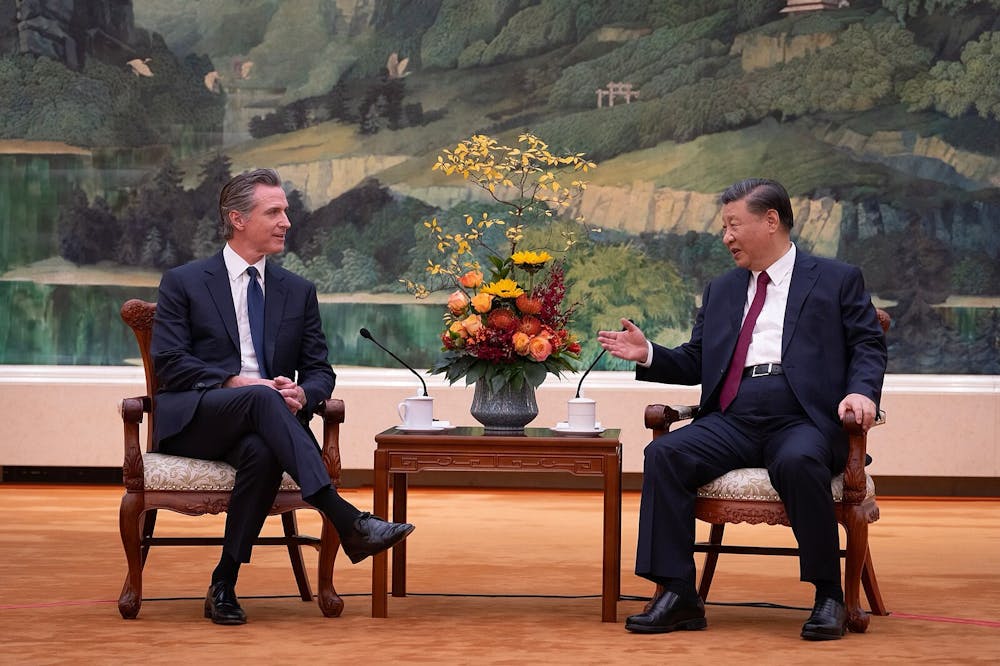By Paige Gould
Correspondent
Unexpectedly, the California Gov. Gavin Newsom visited China’s president, Xí Jìnpíng to discuss climate change action on Oct. 25. Newsom also met Chinese Foreign Minister Wang Yi and Vice President Han Zheng.
Soon thereafter, Newsom intrigued Chinese officials as they discussed opportunities to deliver climate crisis action mostly due to California’s robust economic market. The U.S.–China trade system benefits from California’s unique multi-billion dollar economic ties to China by trading high technological innovations and goods; Newsom used this relationship to bolster a stronger and more immediate collaborative effort to combat the climate crisis.
Newsom also discussed his decision to invest in increasing California’s dependence on carbon neutral energy sources. Together, California and China made a declaration to commit to reusable energy sources, as expressed by The Independent, with, “offshore wind, advanced energy storage technologies and zero-emission vehicles.” Whether this new policy will be enforced remains to be seen, but the initiatives taken are encouraging to tackle the climate crisis.
President Xí also expressed concerns that the black market smuggles fentanyl through China, exports to Mexico, to be sold back to the states, further worsening the fentanyl epidemic in the U.S. by increasing opioid overdose–related deaths. Newsom stressed the need to strengthen the U.S. and China’s relationship to combat high priority issues.
The governor's office steered Newsom away from the discussion of China's persistent pro-democracy protests and human rights violations in Tibet, Tawaiian, Hong Kong and Xīn Jiāng. As explained by AP News, Newsom later expressed solidarity with the official U.S. policy and affirmation of the “one China policy.” This policy allows the United States to acknowledge the People’s Republic of China as the legal government of China, and Taiwan is a part of mainland China. The U.S. maintains official relations with PRC while being Taiwan’s largest unofficial supporter with a growing military presence as PRC grows more hostile towards Taiwan’s self-governance.
Newsom’s talks with national and local leaders spark hope that, in November, President Xí and President Biden will assemble to talk at the Asia-Pacific Economic Cooperation summit in San Francisco. As emphasized by Politico, the domestic policies of the U.S. and China do not align with their distinct agendas. For example, this summer, President Xí refused to meet with President Biden’s climate envoy, John Kerry, saying, “China’s commitment to the climate crisis will go the way we plan it to go at our own pace.”
This highlights the high tensions as reducing carbon emissions now would stave off the most detrimental and categorically catastrophic climate crises to come. The destiny of the climate crisis depends on the policies put forth by both the U.S. and China to ease the effects of climate catastrophes to the most disproportionately vulnerable places. The differences between these two countries have become contentious, making the path to tackling the climate crisis arduous.
Provoking an amicable relation among nations is what is needed to mobilize an international effort to combat hazardous carbon emissions for the hope of a better future. In hopes to release tensions abroad, maybe the students at the College can release tensions locally as they reflect on their budget.
As the College leans more toward solar energy sources and reaches the seven year anniversary of the EV charging stations, the solar-powered tables students use to charge their electronic devices has become a popular study and hangout spot on campus. All this to say that the College has become more ecologically aware of the impacts of climate change in attempts to mitigate it. But, are there more things the College can commit to that will lower carbon emissions?
In order, to mitigate further environmental harm, the Climate Leadership Commitments highlights important guidelines to help alleviate symptoms from the climate crisis. Based on the Climate Leadership Commitments, the College should track and regulate; fuels, animals, refrigerants, fertilizers, chemicals, utility consumption or air travel paid by the institution (including the two-round trip tickets for the interim President to enjoy coach seats on airfare and ground transportation to visit family in California every month). Taking these factors into consideration, the College still has a long way to go.
Moving forward, in order to resolve the climate crisis, collaboration, compromise and understanding is needed between all parties involved whether it be between the U.S. and China or the College’s students and the College’s administration.







